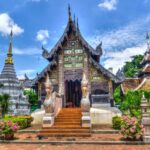Thailand’s red light districts represent a complex and controversial aspect of the country’s social and economic landscape, deeply intertwined with historical, cultural, and economic factors. These areas, primarily located in major cities like Bangkok and Pattaya, have gained international notoriety for their adult entertainment venues and sex tourism industry. While often sensationalized in media, these districts are multifaceted environments that reflect broader socioeconomic challenges, including poverty, gender dynamics, and economic opportunities for marginalized populations. Understanding these areas requires a nuanced perspective that goes beyond simplistic moral judgments and recognizes the intricate human stories behind the neon lights and crowded streets.
Historical Context and Social Origins
The emergence of Thailand’s red light districts can be traced back to complex historical developments during the mid-20th century. Following World War II and the Vietnam War, economic instability and limited employment opportunities for rural populations, particularly women, contributed to the growth of sex work as a survival strategy. American military personnel stationed in Thailand during the Vietnam War era significantly influenced the development of these entertainment zones, creating economic ecosystems that persisted long after military presence diminished. Economic disparities between urban and rural regions drove many young individuals from impoverished provinces to seek income in major cities, with sex work becoming a perceived pathway to financial stability.
Sociological research indicates that these districts evolved from traditional economic survival mechanisms into complex social environments with their own intricate cultural norms and hierarchies. The sex industry became not just a means of individual economic survival but a broader economic sector generating substantial revenue for local communities and national economies.
Geographic Concentration and Major Areas
Thailand’s red light districts are predominantly concentrated in specific urban zones, with Bangkok’s Patpong, Nana Plaza, and Soi Cowboy, and Pattaya’s Walking Street being the most internationally recognized locations. Each area possesses unique characteristics, attracting different demographics of both workers and visitors. Patpong, originally established in the 1960s, represents one of the oldest such districts, initially catering to American military personnel and later evolving into a tourist attraction. Nana Plaza, often referred to as the









